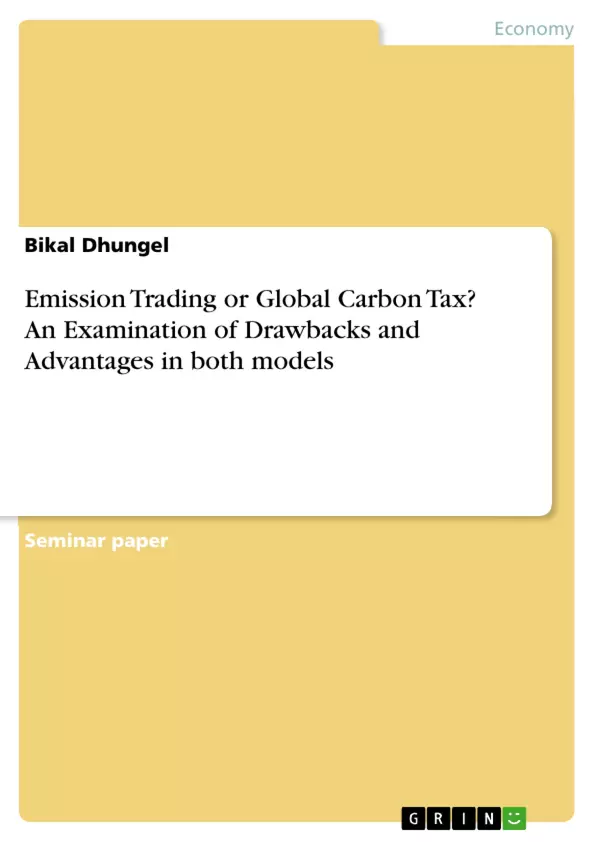Following the introduction, important terms will be defined. Arguments about the advantages and disadvantages of both approaches will be discussed briefly, followed by a closer look into some scholarly evidence.
Inhaltsverzeichnis (Table of Contents)
- Introduction
- Definitions
- Drawbacks of Global Carbon Taxes (GCT)
- Drawbacks of Emission Trading Scheme (ETS)
- Evidences
- Evidences of (Global) Carbon Tax
- Conclusion
Zielsetzung und Themenschwerpunkte (Objectives and Key Themes)
This essay aims to compare and contrast the effectiveness of Emission Trading Schemes (ETS) and Global Carbon Taxes (GCT) in reducing greenhouse gas emissions, focusing on the North-South divide in climate change policy.
- The essay explores the advantages and disadvantages of both ETS and GCT approaches.
- It examines the potential economic impacts and challenges of implementing a global carbon tax, particularly on developing countries.
- The essay highlights the importance of achieving cost-efficiency and environmental effectiveness in tackling climate change.
- It discusses the complexities of international cooperation and negotiation in implementing climate change policies.
- The essay explores the potential for both ETS and GCT to incentivize innovation and investment in cleaner technologies.
Zusammenfassung der Kapitel (Chapter Summaries)
- Introduction: This section provides an overview of the global climate change problem and the need for international cooperation to reduce greenhouse gas emissions. It introduces the two main policy instruments – Emission Trading Schemes (ETS) and Global Carbon Taxes (GCT) – that are compared in the essay.
- Definitions: This section defines key terms related to carbon emissions, including Emission Trading Schemes (ETS) and Global Carbon Taxes (GCT). It provides specific examples of ETS implementation, such as the European Union Emission Trading Scheme (EU ETS).
- Drawbacks of Global Carbon Taxes (GCT): This section discusses the challenges and potential drawbacks associated with implementing a global carbon tax, including concerns about distributional equity and the potential for relocation of firms to countries with lower tax rates.
- Drawbacks of Emission Trading Scheme (ETS): This section explores potential drawbacks of ETS, including the issue of price volatility and uncertainty. It discusses how fluctuating allowance prices might disincentivize firms from investing in low-emission technologies.
- Evidences: This section presents empirical evidence from various studies examining the effectiveness of carbon pricing mechanisms, including both ETS and GCT. It discusses the mixed results and potential limitations of these studies.
Schlüsselwörter (Keywords)
This essay examines the key issues surrounding carbon pricing mechanisms and their impact on reducing greenhouse gas emissions. Key terms and concepts include: Emission Trading Schemes (ETS), Global Carbon Taxes (GCT), climate change, North-South divide, cost-effectiveness, price volatility, economic impacts, innovation, and cleaner technologies.
- Citar trabajo
- Bikal Dhungel (Autor), 2015, Emission Trading or Global Carbon Tax? An Examination of Drawbacks and Advantages in both models, Múnich, GRIN Verlag, https://www.grin.com/document/305980



